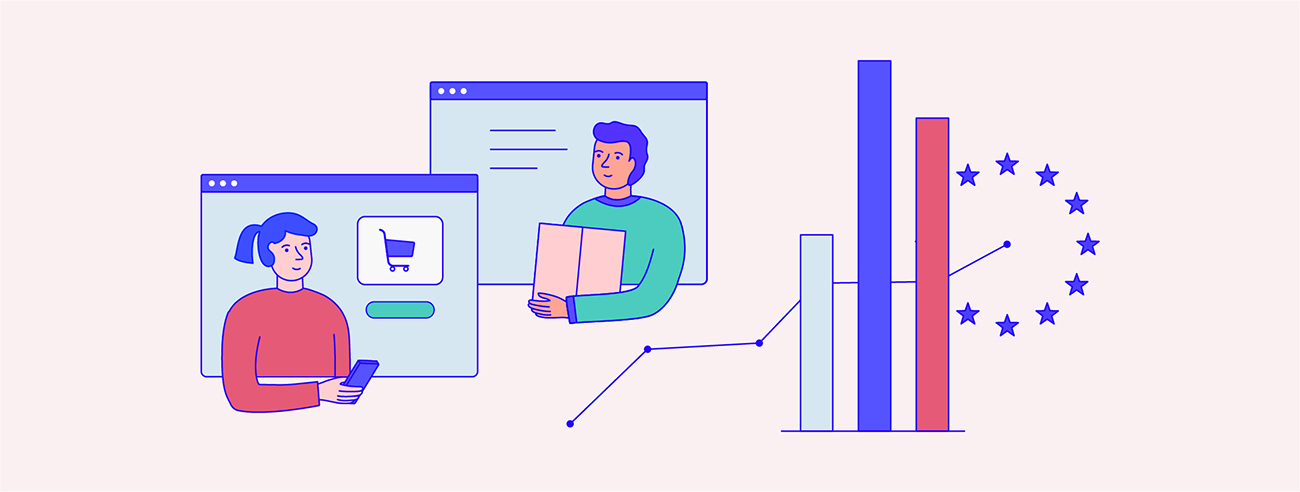European eCommerce: Promoting Resilience in a Disrupted Market

In this blog, we give readers a peek at our European eCommerce Report, which offers insights on consumer shopping behavior and fraud trends unique to the European eCommerce landscape.
European eCommerce began 2020 poised for continued accelerated growth – and then the pandemic hit, thrusting eCommerce into the spotlight. Now more than ever is the time for merchants operating in Europe to meet customers’ increasingly sophisticated expectations, and provide a consistent experience across channels and borders.
Our European eCommerce Report, Promoting Resilience in a Disrupted Market, discusses the key trends impacting the European eCommerce landscape in 2020, and how merchants can address them by bolstering their omni-channel strategy and empowering cross-border shopping. It includes insights on the power of mobile apps; the rising popularity of alternative fulfillment methods; the benefits and risks associated with global expansion; and, of course, adapting to post-crisis consumer preferences.
In this blog, I’ll share some of the report findings.
Adapting to a post-crisis eCommerce landscape
Consumer shopping habits during the initial stages of the Coronavirus pandemic have already been discussed at large. In February-March, we saw customers stockpiling on essentials and avoiding discretionary spending. In April and May, sales volumes across most eCommerce industries began to stabilize, but some shopping habits have changed significantly. It seems the pandemic has sped up the transition to mobile commerce for many consumers, and introduced new considerations such as contactless shipping. Many merchants also saw an increase in first-time customers. All players in the eCommerce space should understand these changes in order to ensure that first-time customers will return.
Providing a true Omni-channel experience
mCommerce
Today’s customers want to be able to make purchases whenever and wherever the need or inspiration arises – and they expect to have a seamless experience, every time. Mobile commerce is already overtaking desktop eCommerce in the biggest European markets, but mobile shoppers are over 50% more likely to abandon their purchase than desktop shoppers. That’s because mobile consumers are more sensitive to friction, making invisible, instantaneous fraud detection all the more important. The good news is that, according to Riskified data, mobile apps are almost one-third less risky than average in Europe.
Fulfillment
In many parts of Europe, alternative fulfillment methods such as in-store collection and returns are rising in popularity. For many customers, Buy Online, Pickup In-Store (BOPIS) is a simple way to circumvent long lines and save on shipping costs. For merchants, incentivizing customers to choose BOPIS drives footfall to stores, where enticing displays and promotion present the opportunity to upsell. BOPIS carries greater fraud risks, as the lack of shipping address leaves a blind spot for fraud review. However, countries like the UK demonstrate that as BOPIS becomes more prevalent, risk levels decrease.
Merchants must overcome technological and logistical challenges to support all of these channels, while minimizing exposure to new fraud risks. Those that succeed will be well positioned to grow sales and remain competitive against other players in the eCommerce space.
Empowering Cross-Border Shopping
More than one-third of European shoppers already make cross-border purchases from other countries within the continent, and that number is growing. Removing barriers for non-domestic shoppers can be a huge engine for growth. Many, however, remain wary of expansion, fearing unfamiliar eCommerce cultures and unknown fraud risks. Machine learning fraud solutions review orders from different geographies based both on previous experience and emerging fraud trends, dramatically reducing the risk associated with international expansion.
Fraud isn’t the only challenge associated with cross-border expansion. Competition from international marketplaces is heating up, and policies and politics from PSD2 to Brexit are going to change the way European merchants and consumers interact. But by overcoming these challenges and catering to a continent-wide audience, merchants can find immense opportunities for growth.
Download the Full Report
These are just some of the insights included in our special report about European eCommerce in 2020. For more insights and fraud prevention best practices, download a complimentary copy of the full report.


